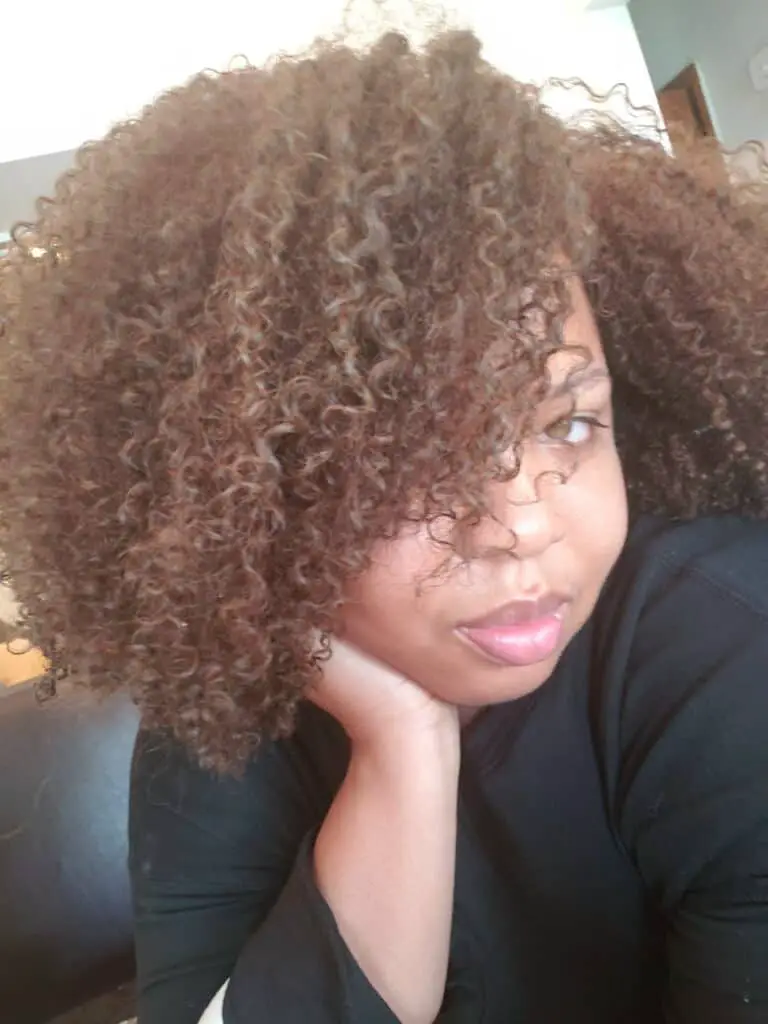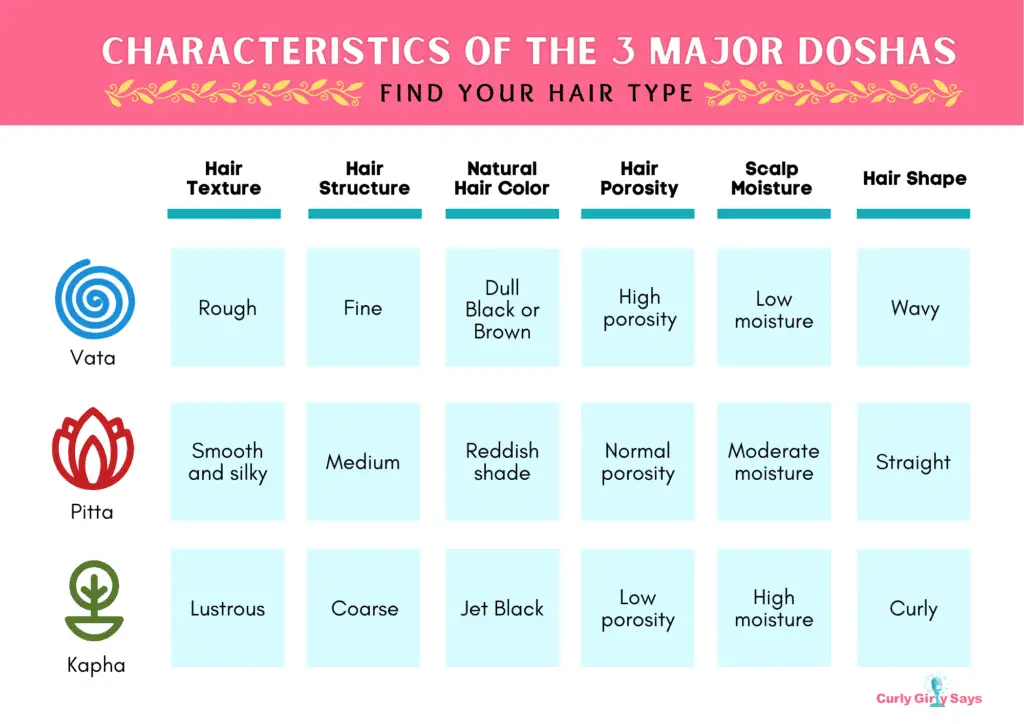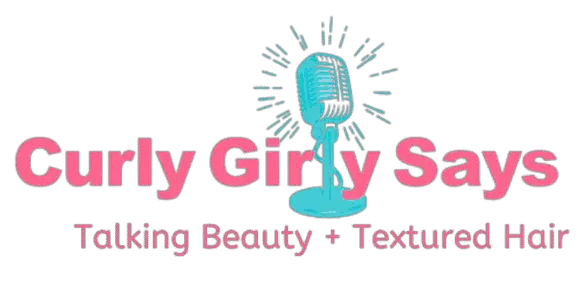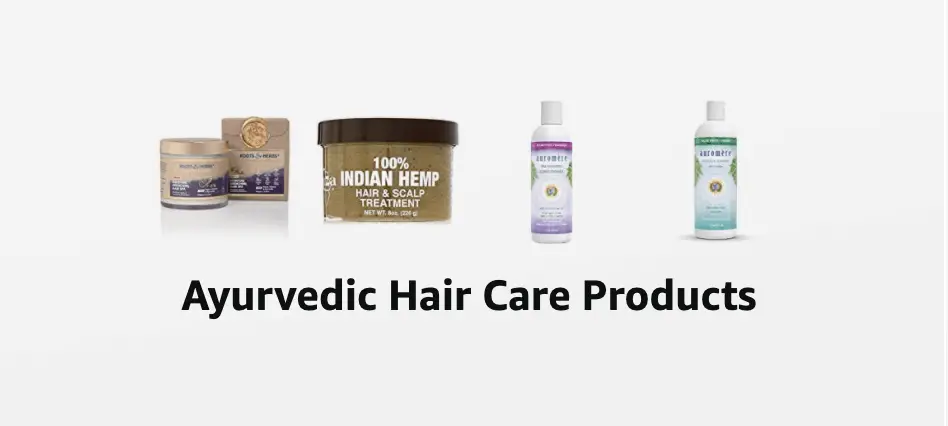Recently I started implementing the Ayurvedic (EYE + YUR + VAY + DIC) approach into my haircare treatment and have been blown away by my results. My curls are healthy, my scalp is thriving and my 4a coils are moisturized and shining.

Hence why I put this detailed guide, Ayurvedic Hair Regimen for Beginners together. I want you to experience thriving curls too! So let’s get into the basics of Ayurvedic hair care.
First up…
Table of Contents
What is Ayurvedic Hair Care?
The principle of Ayurveda is that every person is made up of a unique amalgamation of three energy forces. These are called the doshas, where the forces of energy are each called vata, pitta, and kapha.
According to the philosophy, we must maintain a balance between these three energy forces. Doing so ensures that we are always in optimum health and that every part of our body, including our hair, is kept healthy and strong.
Ayurvedic medicine depends on different herbs and oils that retain a balance between the three energy forces (vata, pitta, and kapha) in your body. For this to be successful, you also need to make diet and lifestyle changes that are healthy.
Once all of your doshas are balanced, you can have the healthy hair that you seek.
The Ayurvedic Hair Regimen
Since the Ayurvedic method is connected with nature and natural things, an Ayurvedic hair care regimen only allows you to use products that are 100% natural. This means you have to omit chemical products and switch to naturally processed ones.
Although there are many products on the market that claims to be natural, however, they wouldn’t be considered natural by the Ayurvedic standard, which is a high one.
You also need to remember that the Ayurvedic approach doesn’t end with just your hair.
You need to incorporate natural supplements into your diet so that you’re treating your issues from the very root.
Also, the Ayurvedic process does not change your hair structure in any way. This medicinal practice only works by respecting your fundamental hair structure and fostering existing properties in your body to encourage your hair to be on its best behavior always.
Therefore, the key to creating a proper Ayurvedic hair regimen is to know your hair type and structure before you move on to the hair care recipes and routines.
Join the Ayurvedic Hair Growth Series
Let’s get back to our roots!
In the world of modern medicine with chemicals and the urge for immediate validation, we often forget that our ancestors survived for centuries on natural remedies alone. While I fully understand the need for modern advancements, I like to take a different approach when it comes to hair care.
Join this FREE 5-day email hair care and hair growth course that spoons feed you everything that you need to know about Ayurvedic Hair Care. Sign up below to grow long, strong, and healthy hair!
Know Your Natural Hair Type According to Ayurveda
The three doshas present in your body determine what your hair type and health are like. While we have a combination of three energy forces, one or two of them typically are more dominant within you.
1. Vata Hair
If you are Vata-dominant, your hair type would be thin, straight and usually with higher porosity. You might also be prone to dry hair or hair breakage more often than others, and your hair’s texture tends to be rough.
Vata dosha causes a low sebum production that results in this sort of hair dryness. The way you can keep your Vata in balance is by feeding your hair proper nutrition at its follicles.
2. Pitta Hair
With a Pitta-dominant dosha, you will most likely have softer and wavy hair with a smooth texture. Pitta bolsters your metabolic activity and controls the production of pigments and hair proteins.
The issues people with an imbalanced Pitta-dominant dosha typically face are premature greying, scalp inflammation, redness, hair loss and clogged follicles from bacteria build-up.
3. Kapha Hair
Kapha-dominant dosha hair types are curly, thick and shiny. This dosha regulates your hair structure and its production of lubrication.
This means an imbalanced Kapha leads to an overproduction of sebum that causes oily and greasy scalps. You may also suffer from dandruff, itching, and breakage.
It is important to note that most of us with imbalances are not purely Vata, Pitta, or Kapha dominant. Instead, many of us will have a combination of two or even all three doshas. The below dosha types should be used as a guide in understanding that you will have blends of imbalances rather than one sole dominant imbalance.
For example, my hair characteristics are mostly Kapha with Pitta hair porosity and scalp moisture, and Vata hair color.

The goal of the Ayurvedic Hair Care approach is to balance your imbalanced doshas through the usage of 100% natural oils, herbs, and a proper diet. The Ayurvedic Approach is a holistic approach to hair care.
The Different Types of Ayurvedic Hair Care Recipes
There are a variety of topical applications in ayurvedic hair treatments. From hair pastes to teas and masks, you can incorporate herbs and oils in several recipes.
Here are some of the common types of ayurvedic hair care recipes that stimulate your scalp and balance your doshas to promote blood circulation and hair growth:
Hair Masks/ Paste
Hair masks are great when you want to add different natural ingredients to nourish your scalp and provide it with necessary nutrients.
For a hair mask or paste, you would dissolve some powdered herbs with either water or a liquid substance. This typically acts as a conditioner for your hair and has a very thick consistency.
For pre-poo or deep conditioning treatments, you can mix cassia, hibiscus, amla, rosemary and mint with warmed milk to form a concoction. Once the milk is steeped with the herbal ingredients, you can strain the herbs out and add honey and Fenugreek seeds (soaked overnight) to create a paste for your hair.
Another popular Ayurvedic ingredient is henna, which can be used to moisturize, color and strengthen your hair. This paste is very potent and so, should be used sparingly.
Hair Glosses
A hair gloss is a milder formula than a hair paste or hair mask.
Hair glosses typically use a smaller quantity of Ayurvedic herbs. You can choose to add in water or another liquid to emulsify the mask and make it thick enough to smear over your head.
The common ingredients used are yogurt, coconut milk, avocado, aloe vera, bananas or even a chemical-free conditioner.
While a hair gloss does contain the same benefits as a hair mask/paste, it is relatively less strengthening and works more as a moisturizer for your hair.
For a moisturizing hair gloss Ayurvedic recipe, you can add aloe vera juice and mix it with any of your favorite Ayurvedic power such as alma, henna powder, neem, spirulina, wheatgrass and more.
Hair Teas and Rinses
If you want your hair to be soaked rather than covered with drying pastes, you can use ayurvedic teas and rinses.
This process can take longer than making a paste or gloss but it is less messy in terms of application. You can apply your tea daily by storing it in an empty spray bottle and spritzing it into your hair. For the rinse, you can use the liquid to wash your hair either before or after conditioning.
To make an ayurvedic tea, add your favorite Ayurvedic herbs to a kettle or pot of boiling water. You’ll need to let it steep overnight and, in the morning, strain the herbs from the solution.
If you find that the tea has a pungent smell, you can also add essential oils without altering the tonic.
For an ayurvedic rinse, you can use apple cider vinegar but remember to dilute it by adding at least 5 to 10 parts of water with 1 part of ACV.
Herbal Hair Oils
If you use particular oils on your hair as part of your standard hair care regimen, you can add in Ayurvedic herbs to gain more benefits from the mixture.
You can add in any of your favorite Ayurvedic herbs with either cold or hot oil. However, make sure you are careful with much you heat the oil and test it on your skin before applying it to your scalp.
Ayurvedic treatments give oil massages a particular prominence. This is because it stimulates blood circulation in your scalp and also promotes hair growth, and it’s recommended that you do this once or twice weekly.
To infuse oils with Ayurvedic herbs, you can use any one of your favorite hair oils. This can be coconut, almond, olive oil etc. Add in your herbs of choice and apply them to your scalp overnight.
Using an oil treatment overnight helps all the nutrients to steep inside of your scalp and hair follicles more deeply. This ensures maximum penetration and offers great benefits to your hair.
Afterward, you can use an Ayurvedic herbal shampoo or co-wash to remove all of the excess oils to avoid getting your scalp greasy.
Popular Ayurvedic Hair Care Products Ingredients
Most Ayurvedic herbs offer similar benefits but as a beginner, you may not be familiar with all of them.
Therefore, below is a list of the most common Ayurvedic herbs found in Ayurvedic hair products:
Bhringraj
This Indian herb is full of vitamins, calcium, magnesium and iron. The oil that’s extracted from this herb can help diminish problems relating to hair loss and dullness.
It also soothes your scalp by increasing blood circulation and activates the follicles in your hair to promote natural hair growth.
Brahmi
This herb of Ayurveda is also considered a ‘wonder herb’ due to its hair growth and hair thickening properties.
If you suffer from thinning of hair, you can use this oil to massage your scalp and improve hair growth. The oil also has an alkaloid that produces a protein in your body that can strengthen your hair follicles to be more resilient against damage.
You can also use it to calm down since it induces a soothing feeling when massaged on your scalp.
Neem
Neem comes from the fruits and seeds of the neem tree. These trees grow mainly in the Indian subcontinent.
Neem is a herb known for healing and antifungal properties. It also helps to treat dandruff and can help people who suffer from alopecia.
Amla
Amla is a potent source of Vitamin-C. It also contains essential fatty acids and antioxidants that are an important addition to your hair care regimen.
Amla reduces dandruff and eliminates grease and dirt from your hair follicles. It also provides the nutrients necessary to make your hair stronger and have more luster.
Fenugreek Seeds
This herb is also a spice used in Indian cooking. To use it on your hair, you need to soak the seeds overnight and grind it until it turns into a fine paste before applying to your hair.
The seeds are rich in vitamin A, C and K as well as proteins and folic acid. This makes it one of the best Ayurvedic medicines due to its high nutrient content.
You can use this to combat hair fall and dandruff as well as other scalp problems. It also nourishes your hair and induces hair growth.
Shikakai
Shikakai contains great hair-cleansing properties and can even be used as a natural shampoo.
Since it is rich in antioxidants, you can use it to promote natural hair growth and add nourishment to your hair.
Ayurvedic Hair Care Routine
Once you’ve chosen the best Ayurvedic hair product for your scalp and hair issues (consider which one of the Ayurvedic hair types you fall into), you can start preparing a suitable hair care regimen for yourself.
As a beginner, you can start slow by gradually incorporating Ayurvedic herbs and oils into your standard hair care regimen. For example, you can mix in a bit of Brahmi oil to your typical conditioner and use it as a co-wash.
After you are comfortable using Ayurvedic ingredients, you can move on to a proper Ayurvedic hair care routine. Here are the steps of how to get started:
1. Start Oiling Your Hair Weekly
Ayurvedic treatments recommend that you oil your hair 2-3 times every week. You can choose the type of oil-based on your existing hair issues or the oils that match your dosha.
If you have a Kapha hair type, you can oil your hair less frequently while someone with a Vata hair type needs almost regular oiling.
For the best results, oil your hair at night and wash it off the next day. If you can’t do this, try oiling your hair for at least 20 minutes before you head into the shower.
Use circular motions to stimulate blood circulation when oiling your hair.
2. Use Ayurvedic Shampoos to Wash Your Hair
Use either an Ayurvedic shampoo or 100% herbal shampoo to cleanse your hair at least twice or thrice a week. This will ensure that your scalp follicles do not get clogged with the build-up of excess oils, dirt or grease.
If you want to be more committed to Ayurvedic practices, you can pick a shampoo that contains herbs related to your dosha imbalances.
3. Use Hair Masks to Condition Your Hair
Ayurveda recommends that you apply hair masks at least once a week or every other night to keep your scalp in the utmost health.
You can make your own combinations of Ayurvedic ingredients with a solvent (e.g., egg white, aloe vera gel) to prepare your hair masks. Powders such as Amlaki, henna, fenugreek can create nutrient-rich hair masks that offer tons of benefits to your scalp and hair.
Once you’ve combined all your ingredients, apply the mask by starting at the root of your hair to the ends. Use this for at least 40 minutes before you rinse it off with water.
4. Use a Wooden Comb to Brush Your Hair
According to Ayurveda, you should comb your hair with a wooden blunt-toothed comb daily. You can use this after you’ve showered or somewhere in the middle of the day.
It’s especially important to brush your hair if you’ve been outside as it will remove all of the dirt that has accumulated in your scalp and hair follicles.
If you are trying to fight off dandruff, it’s recommended that you use a neem wooden comb. Another rule is to wash your comb regularly after you’ve used it to avoid reintroducing dirt and grime to your scalp.
5. Avoid Using Chemical Products
The important rule of Ayurvedic hair care treatments is to either minimize or banish all chemical products in your existing hair care regimen.
When you’re using natural oils in your scalp, you provide necessary nutrients that help solve issues from hair loss to dandruff and hair thinning. However, using harsh chemicals can create greater imbalances in your hair’s pH level and sometimes strip the natural nutrients from your roots.
Try searching for herbal or natural alternatives when shopping for your hair care products to avoid risking hair damage.
6. Style Your Hair with Ayurvedic Herbs
Styling is a big thing for us. It let us show off our personality and explore our creative side.
Yet, using chemical products while styling your hair would upturn all of your progress with an Ayurvedic hair care regimen. So, instead of damaging your hair with chemical styling products, switch to an Ayurvedic alternative instead.
An ayurvedic flaxseed gel, for example, works wonders in installing your twists while also strengthening the ends of your hair and preventing tangles.
Change Your Lifestyle to Get the Full Ayurvedic Hair Treatment
Ayurvedic treatments aren’t simply incorporating natural herbs into your existing hair care treatments. It’s deeper than that.
This form of alternative medicine believes in curing someone from the very root of their problem. This means that your lifestyle conditions are factored in with your hair and skin problems.
If you want to achieve the full benefits of Ayurvedic treatments, you need to look into things such as your diet, physical activity and other health-related areas.
When you start following a balanced nutritional diet with regular exercise, you detoxify your body of bad chemicals. Being healthier can help keep your dosha in balance and ensure a long-term solution to all of your hair, skin and health issues.
Want to Learn More about Ayurveda and Hair Care?
Although this is an extremely detailed article, I also highly recommend this $7 ebook. UK Beauty did an amazing job breaking down Ayurveda and Hair Care in a holistic way. She goes into gut health, bone health, and how it all ties back together to hair. She also gives detailed remedies and DIY recipes with directions that make it easy to follow.
This was the first resource that I purchased to learn more about Ayurveda and hair care, and I’m so thankful. UK Beauty made it easy to follow and explained every little step.
This Ayurveda guide covers the below bullets and so much more!
- Discover your own Ayurvedic hair type
- Learn about what herbs and oils work best for your hair
- Find out what hair problems you are more susceptible to
- Discover how your hair is connected to your bones
- Find out the best foods to include or avoid to get beautiful hair
- Create your own hair products







I recently started learning about ayurvedic hair care and this is great!! It gives me so much information!
Hi Amara, I’m glad that you found the info in this article relevant. I’m totally loving this approach to hair care!
This is such a great. I’ve never tried a hair tea rinse or herbal oils. After having my baby, my hair has been a little dull and could use some more love, haha. Thanks for the ideas!
Anaiah, you are so welcome. My hair was dull as well after having my daughter. I totally see a difference for the better since using the products mentioned in this article.
I think mine falls with vata hair, great and interesing information here!
Hi Jeannie, Thank you. I’m so happy you found this information interesting!
Interesting article! I practiced yoga but never heard about dosha care for hair. I`ll follow your tips.
Thank you Olga. You will definitely see improvement in your hair following these tips1
This was a very interesting read. I have never heard of ayurvedic hair care before. It makes a lot of sense, though.
Thank you Ben. It really does when you think about it.
I have to give this approach to hair care a try. I’ve always been a believer in natural and individualized care.
I think you would really find Ayurveda beneficial!
I’m not familiar with this type of product. I don’t really have enough hair left to matter, but I do have issues with dry scalp and it would benefit me to do something about it.
Hi Bryan. Yes, you can definitely benefit from this hair care regimen.
My hair has been a disaster since I had kids. I can use all the help I can get.
Then this hair care regimen is for you!
I think this hair care regimen will work well for me since I love anything natural. I’m turning 40 this year and I think my hair has become lifeless and limp already.
Hi Ivan, You would definitely benefit from using some of these products.
I think I have Pitta hair, although my natural hair color is black. I do suffer from hair fall and I would want to try these hair care products. Thanks for this very helpful article.
Hi Eileen. You are very welcome. We usually have a combination of the doshas and you would definitely benefit from using these products.
I would love to find a good treatment that works on my hair aswell, I have that thin straight blonde scandinavian hair most treatments I have tried just give a greecy feeling.
Hi Ann. It seems like you suffer from overproduction of sebum which is a Kapha imbalance. These products would help with that imbalance.
I’m from India and i know every thing about Ayurveda. It’s surprising to see your knowledge about this.
Hi Anshika. Thank you. I started learning Ayurveda at the top of the year and my hair is thanking me.
I love the idea of a personalized, all natural approach to hair care. Everyone’s hair is different!
Yes…I love the idea of personalization. Those types of routines seem the most effective.
In all honesty, this is my first time hearing about ayurvedic hair care. I am glad to know things about this, and I think this regimen will help my sister’s hair to make it softer and stronger.
Yes. Please share with your sister as I’m sure she will find it beneficial.
Using natural ingredients is a good idea. I am always happy to hear new ideas to help with better hair.
Yes! You can never go wrong using natural ingredients.
Your hair looks amazing!! Thanks for breaking down all of those different ingredients. I might have to try some of them and see if my curl texture improve.
Hi Natalie, Thank you so much. You should definitely give some of these products a try. Your hair will thank you later!
This is really great advice! Definitely something that we should all be thinking about implementing.
Thank you Emily.
Oh wow, I learned something new reading this article! I need to try out this kind of hair regimen.
I’m glad that you found this article helpful and informative!
I need to try some of these on me and my dauther! We have such different hair so it’s been a challenge deciding what works best for each of us!
Hi Brianna, I think you will definitely find some of these products beneficial for you and your daughter.
I love that you are including diet tips such as supplements. Our inner health makes a huge difference in our hair health.
It really does Elise. Thank you!
Ayur Luxe brand by Christian Karega seems like a good choice. I love the packaging too! So nice!
Yes…me too. It is very luxurious : )
I have never heard of this but it sounds super interesting!
Thank you Neely!